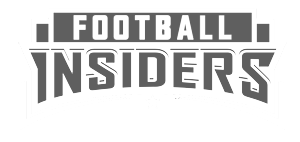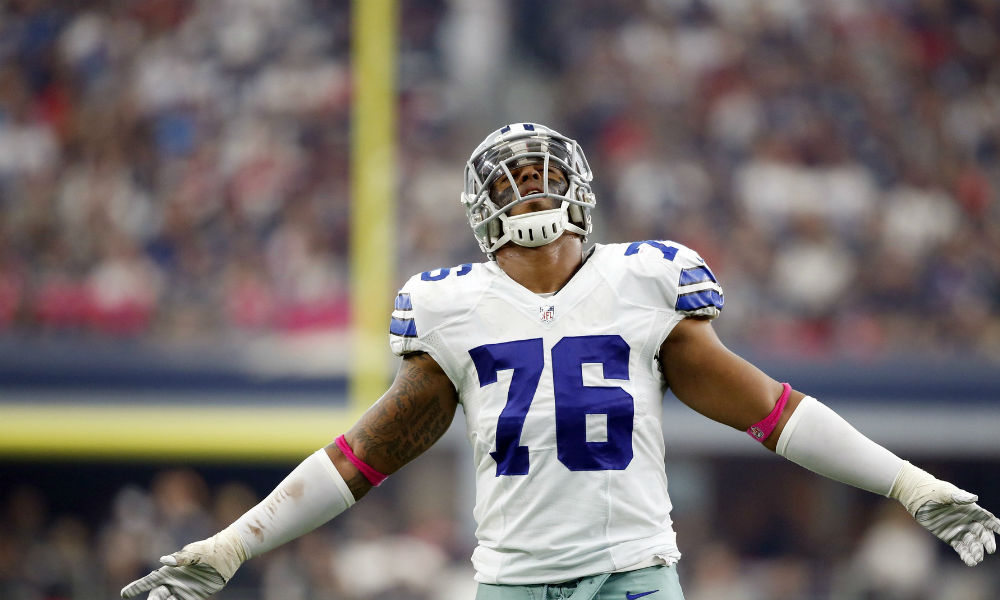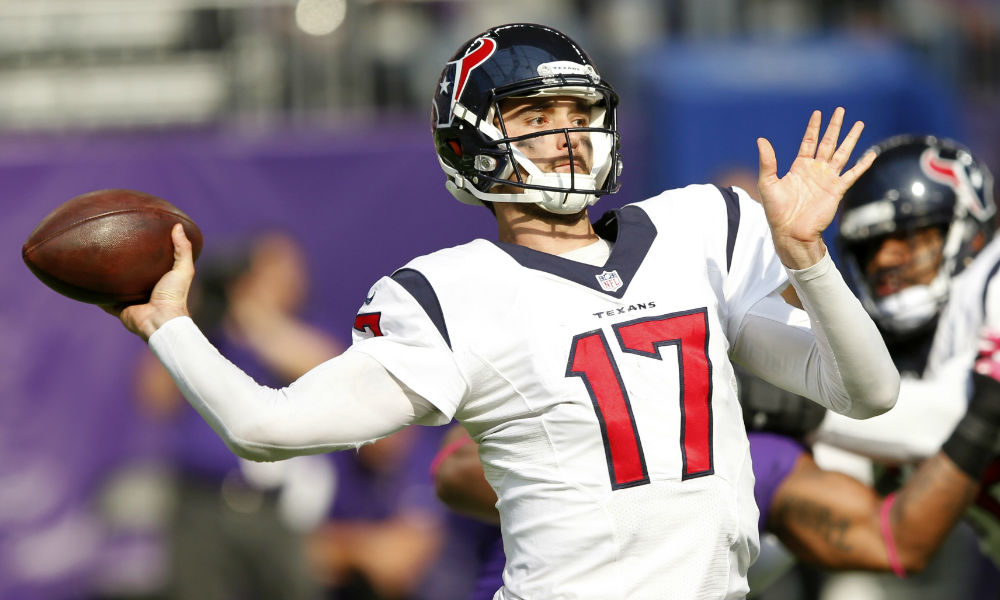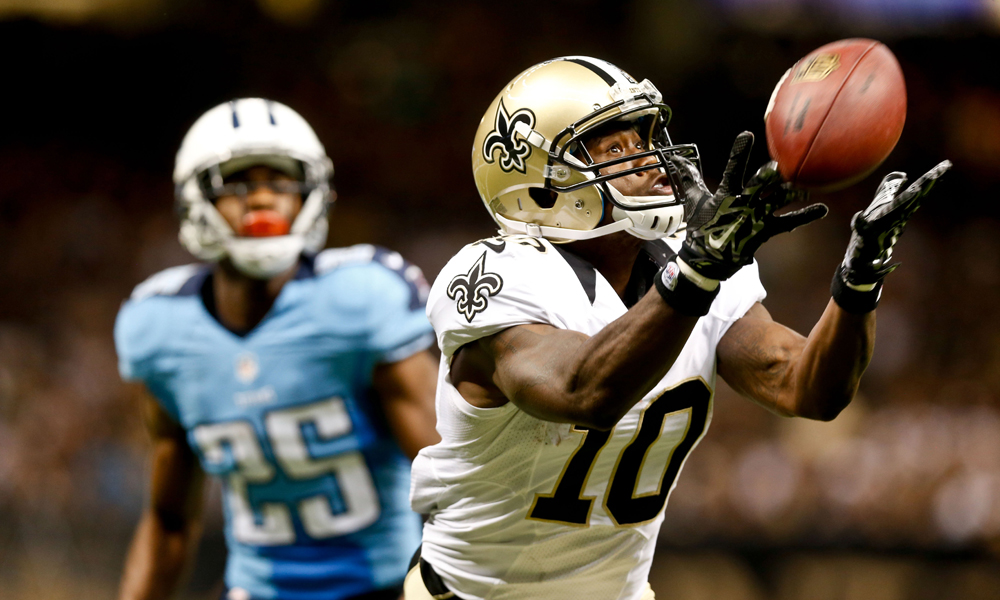News
Five Critical Questions Facing The Philadelphia Eagles
For better or worse, Chip’s bunch might be the NFL’s most questionable entering 2015.
Perhaps no NFL team has more questions to answer heading into the 2015 NFL season than the Philadelphia Eagles.
The Eagles were on the cusp of something special last season. Aiming for their second straight NFC East crown, they got off to a 9-3 start, complete with a Thanksgiving Day win over the Dallas Cowboys to take command of the division title picture. But it all came unraveled in a disastrous December for Philly. Consecutive losses to Seattle, Dallas and Washington knocked the Eagles from the catbird seat completely out of the playoff picture and although they finished the season at 10-6, it was a tremendous disappointment given how they got there.
That sent the Eagles into an important offseason, and they made it more interesting than anyone expected, with trades and free agent signings that created quite a bit of roster turnover. While expectations are high internally for Philadelphia in 2015, their offseason maneuverings have left many wondering what fate awaits these Eagles. To meet their own expectations, they’ll have to answer these five critical questions (and probably a few more).
HOW MUCH DOES OFFENSIVE CONTINUITY MATTER?
The majority of the turnover on the Philadelphia roster was on the offensive side of the ball, where Philly now has a new quarterback, two new running backs, a new lead wide receiver and two new starters on the offensive line.
The Eagles opened the new league year with a bang when they swapped All-Pro running back LeSean McCoy for linebacker Kiko Alonso from Buffalo and also sent quarterback Nick Foles to St. Louis in exchange for another signal-caller, Sam Bradford. The Eagles then went on a free agent spending spree, highlighted by the signings of running backs DeMarco Murray and Ryan Mathews.
Philadelphia also let free agent wide receiver Jeremy Maclin — who led the team in catches, yards and touchdowns last season — walk and sign with the Kansas City Chiefs. They replaced him with first round pick Nelson Agholor out of USC, who has drawn comparisons to Maclin. But it remains to be seen whether the rookie can step right in and fill those big shoes.
As if that wasn’t enough turnover, the Eagles axed two of their top offensive linemen from last season, guards Todd Herremans and Evan Mathis. Those two likely will be replaced internally, though the team did bring in veteran John Moffitt to compete at one of the open spots, with training camp battles likely to take place at both positions.
So in Week 1 of the 2015 season, Philadelphia will have at least five different starters on offense. That’s a hefty number, especially for an offense that was so strong as a unit last year. Though the season ended in disappointment, the Eagles attack was potent, finishing third in points scored and fifth in total yards per game, including sixth in passing yards and ninth in rushing yards. It was, by all accounts, a Top 10 NFL offense that was largely responsible for the the team’s 10 wins.
Now with so many new faces at important positions, the question is: just how quickly can this crew come together in Kelly’s fast-paced offense to contribute to a successful season?
For many teams, having so much turnover would be a detriment to instant success. However, if there’s one place it can work, it’s in Kelly’s system where the scheme is the star, not the players in it. After all, the basis of Chip’s success with this offense is at the college level, where roster turnover comes with the territory. And the Eagles do still have plenty of talent both with their new acquisitions and in holdovers like their tackles Lane Johnson and Jason Peters, tight end Zach Ertz and wide receivers Jordan Matthews and Josh Huff.
How quickly those pieces can all fit together once training camp begins in early August will be an important factor in determining just how successful and serious the Philadelphia Eagles can be about competing for a championship.
WHO IS UNDER CENTER?
The indecision surrounding this offense begins at the top, where Philadelphia still can’t be sure who will be under center when their season kicks off on Monday night, September 14.
The Eagles took a big risk by acquiring Bradford, who is coming off an ACL injury that cost him all of last season and who is due nearly $13 million in 2015, the final year of his contract. Both the fact that the Eagles traded for him and the size of that contract make it seem obvious that Philadelphia expects Bradford to be the team’s starter at the position this season.
When he’s right, Bradford has all the tools to not only be a passable NFL starter, but to be an outstanding one. He has excellent arm strength, can make every throw, can deftly command an offense, and his decision making has improved. However, he’s been plagued throughout his short career, both by injuries — which have cost him 31 of a possible 80 NFL games over his first five seasons — and by the inadequacies of the talent around him.
His team in St. Louis never had near the talent or offered him the protection in front of him that this Eagles roster does. Despite that, Bradford did have some success when he could stay on the field. In his rookie year, he completed 60 percent of his passes and in 2012, his only other full season, he set high marks for yards and touchdown passes.
He was having his best year yet in 2013 before suffering the first of two ACL tears during a Week 7 game against the Carolina Panthers. He has not been on the field for a regular season game since. Bradford was making progress in the recovery from that injury last summer when he suffered another ACL injury in St. Louis’ third preseason game, bringing his 2014 season to an end before it began.
Bradford is still progressing slowly in the recovery from that injury, which occurred on August 23 of last year. The sixth-year quarterback was limited during Eagles OTAs and minicamp, and the same will likely be true at the start of training camp. At that point he will have five weeks to make enough progress — both health wise and in the Philadelphia offense — to be the team’s opening night starter, a tall task for the 27-year-old former No. 1 overall pick.
So the questions are plentiful. Will he be ready for Week 1? If not then, when? And who steps in?
The Eagles signed Tim Tebow this offseason, adding some intrigue to this situation for some, but I’m not even going to entertain the idea of Tebow serving as Philadelphia’s starter. If Bradford can’t go to start the season, the reins will certainly go to Mark Sanchez, who started the final eight games of the 2014 season, after the since traded Foles went down with a shoulder injury. Philadelphia got off to a great start under Sanchez, with a 4-1 run through November, including a nearly flawless performance by the quarterback in his team’s Thanksgiving Day triumph over the Cowboys.
But Philadelphia’s success as a team masked Sanchez’s shortcomings during that November run. Although he completed better than 63 percent of his passes and threw for eight touchdowns, he was also intercepted six times in four games, including a pair of two-interception contests. When the rest of the team around him started to struggle in December, Sanchez was exposed. Though he completed nearly 65 percent of his passes, he was even more mistake prone, throwing five picks in four games, including two in a devastating Week 15 loss at home to the Cowboys that undid all the good the Eagles had done in Dallas just a few weeks earlier. Sanchez ended up throwing an interception in all four of Philly’s December contests and his struggles were a key factor in their December swoon.
The finish proved once again that Sanchez is probably not cut out to be a starting quarterback in this league. But the Eagles still opted to re-sign him this offseason on an incentive-based two-year deal. The included incentives are based on how many games Sanchez starts over those two seasons. If he starts none, it’s a fairly reasonable deal for a backup quarterback and insurance policy. But if Bradford has a setback, or suffers another injury, Sanchez will assume control of the team and his price will go up, a worrisome scenario for Philadelphia.
Ideally, Bradford will be ready to go, manage to avoid injury, and lead the Eagles to new heights, with Sanchez serving merely as insurance. But the first five years of Bradford’s career have been far from ideal, so we’re not far off from a scenario where Sanchez is trying to lead Philadelphia to the playoffs once more. That would not only make things tougher on the Eagles, but we’d also be forced to seriously question the motivation behind the Bradford/Foles swap.
HOW WILL THE CARRIES BE SPLIT?
While that quarterback swap was a huge move for Philadelphia, ultimately the biggest change for the Eagles came at the running back position. LeSean McCoy had spent six stellar seasons in Philly. He was unquestionably the team’s franchise player and had lived up to the billing. But he was unceremoniously sent packing in a shocking trade. In his stead, the Eagles brought in the league’s leading rusher DeMarco Murray and another 1,000-yard man, Ryan Mathews, formerly of the Chargers.
The impetus behind the initial move was likely McCoy’s clashes with Kelly, which have been reported ad nauseum and were essentially confirmed by McCoy’s remarks in the aftermath of the trade. But whether it was his character, or whether the decision was actually based on the thought that McCoy will soon be entering the decline stage of his career — after six seasons totaling more than 1,400 carries, including more than 600 over the last two — it was probably the right decision for the Eagles to move on.
However, it’s how Philadelphia filled the hole that calls their strategy into question. It appeared the Eagles were initially set to bring in veteran Frank Gore on a reasonable contract to team with Darren Sproles and Chris Polk in what would have been a cumbersome committee for opposing defenses to deal with. However, when Gore backed out at the 11th hour and headed to Indianapolis instead, Philly started putting together a new plan on the fly.
It began with Mathews, and soon after came Murray in an unexpected and quick courtship that ended with the Eagles signing the NFL’s reigning rushing leader to a frontloaded five-year contract with $21 million guaranteed. With those two moves, the Eagles have no doubt built a formidable trio, including Sproles.
But will they be better off than they would’ve been with McCoy? And how will the carries be split between two guys who likely both would’ve been starters if they landed on different teams?
While moving on from McCoy was the right move because of his mileage, replacing him with Murray is questionable based on his own mileage. Dallas essentially ran Murray into the ground last season, piling up more than 400 carries on the now 27-year-old running back between the regular season and the playoffs. No doubt the results were incredible, with Murray leading the league in rushing by nearly 500 yards while the Cowboys marched to a 12-4 mark largely on the strength of his performance.
Many have questioned how much of that success was a result of Murray’s talent and how much can be attributed to Dallas’ vaunted offensive line. That’s a question worth asking. But either way, the statistics show that after such a high volume season, it’s rare for a running back to even come close to duplicating those type of numbers. In fact the last to do so was Eric Dickerson. So there is some definite drop-off to be expected from Murray this season, That’s the primary reason Dallas balked at his contract demands and let him land with a rival.
However, the Eagles are in position to manage Murray’s anticipated decline thanks to their acquisition of Mathews, who himself has had some durability concerns. The 28-year-old is coming off a season in which he missed 10 games due to knee and ankle injuries. But he is just one year removed from his best as a pro, when he played all 16 games and piled up 1,255 yards to help San Diego reach the playoffs in 2013. Splitting carries between the two could be just what each player needs to stay healthy. It could also end up being a detriment to both players. Each has been workhorse running back and those type of backs are known for their need to establish a rhythm to be effective. Philadelphia is obviously counting on it helping, not hurting these two.
One thing the Eagles do have working for them in the running game is that they, like the Cowboys, have a strong offensive line, even if theirs doesn’t get as much press. In fact, Philadelphia graded out considerably better than Dallas in run blocking last season according to Pro Football Focus. Departed guard Evan Mathis was a big part of that success, but the Eagles believe they can manage without him, another case of Kelly’s scheme taking precedence over the stars within it. Despite the changing personnel, Philadelphia’s zone blocking scheme should lead to production. It was a big reason McCoy finished third in the league in rushing yards last year, just over 500 behind Murray despite more than 80 fewer carries, and Philly was ninth in rushing yards last season as a team.
The talent is in place now to not only replicate but exceed that production in 2015. However, this group is likely to be compared to McCoy’s production in Buffalo all season long. If they hit any bumps in the road: if one of the two new backs — both with a long history of ailments — goes down to injury, or if the departure of two guards who performed well in the run game comes back to bite them, Chip Kelly’s offseason plan will once again come under intense scrutiny.
HOW MUCH BETTER WILL THE SECONDARY BE?
As much attention as the Eagles have gotten for the changes to their offense this offseason, they also made sure to upgrade the one key flaw on their defense last season: the secondary.
The Eagles have one of the best front seven groups in the game, but their secondary last season was downright abysmal and the failures of that unit often undermined the effort of their teammates up front. With that in mind, Philadelphia essentially hit the reset button in the defensive backfield. Gone are both the team’s starting cornerbacks last season, Bradley Fletcher and Cary Williams. Also out is strong safety Nate Allen. That leaves free safety Malcolm Jenkins, who actually graded out as the 12th best safety in the league in pass coverage according to PFF, as the proverbial last man standing in the Philly secondary.
But will starting anew lead to secondary success in the City of Brotherly Love?
The Eagles have certainly surrounded Jenkins with several fresh faces they hope will lead to a better unit in 2015. Before they signed Murray, Philadelphia’s biggest acquisition of the offseason was the signing of cornerback Byron Maxwell from the Seattle Seahawks. The Eagles lured Maxwell across the country with a six-year, $63 million contract, $25 million of which is guaranteed. So they’re banking on the 27-year-old former sixth round pick being a star who can lead this secondary for years to come.
They’re also hoping this doesn’t turn out like the last corner they plucked from the West Coast and brought East, Nnamdi Asomugha. After eight excellent years in Oakland, the signing of Asomugha turned out to be a free agent bust for the Eagles and he lasted just two dreadful years in Philly. However, unlike Asomugha, who was living off his reputation by the time he signed with Philly, Maxwell has produced at an excellent rate over the last two seasons. Since becoming a full-time player, Maxwell has been playing opposite Richard Sherman, which made Maxwell a target for opposing quarterbacks by default. But he’s made the most of the opportunities, snatching six interceptions and posting 27 passes defensed over the last two years. His play in the star-studded Seattle secondary was vital to helping the Seahawks reach back-to-back Super Bowls.
However, like Murray, there remains some doubt whether Maxwell’s success is a product of his own play or the system he plays in and the players around him. In Seattle’s Legion of Boom, Maxwell was paired with Sherman and the duo was backed by two of the finest safeties in the game in Earl Thomas and Kam Chancellor. Though Jenkins is very good, he simply isn’t on that level, so Maxwell won’t have that luxury in Philly. Especially with the Eagles still searching for the right answer opposite Jenkins.
Entering training camp, it appears to be a two-horse race. The incumbent is Earl Wolff, a 2013 fifth round pick who disappointed last season, when he was expected to challenge Allen for the job, and was instead reduced to mostly special teams play. The wild card is Walter Thurmond, another former member of Seattle’s Legion of Boom, who signed in Philadelphia this offseason.
After leaving the Seahawks to sign a one-year deal in New York last offseason, Thurmond played in just two games with the Giants before suffering a torn pectoral muscle in the team’s second game. The Eagles brought him in this offseason with an eye toward turning Thurmond, who spent most of his Seahawks career at cornerback, into a safety. Now he appears to have a leg up on the job heading into camp. How he transitions to the role under heralded new Philadelphia defensive backs coach Cory Undlin will be as important as any other factor facing the Eagles over the month leading into the season.
Also vital will be the development of rookie Eric Rowe, who is in line to start opposite Maxwell at cornerback. There were initially questions about what position the 2015 second round pick out of Utah, who has experience at safety and cornerback, would slide into for Philadelphia. But while playing cornerback last month during team workouts, Rowe had jaws dropping and, despite his rookie standing, he quickly moved into position to be one of the team’s starting corners come Week 1.
“I strongly believe the kid can be a top-level corner in this league,” Undlin told ESPN. “The guy is smart. The guy has got some length. He has good change of direction. He’s got everything. Obviously, we took him in the second round. He’s got all the attributes we’d like to hope would make him a good corner in this league.”
It would be a big-time boon for the Eagles, if the second round pick Rowe can produce at a first round level and the free agent acquisition of Maxwell pans out. That would put Philadelphia in good shape at cornerback for the first time in a long time. But between those two and the uncertainty at safety opposite Jenkins, there are a lot of variables at play once again in the Eagles secondary and that means another letdown is possible here.
IS THERE TITLE TALENT HERE?
All these questions surrounding the Eagles point to an even bigger one, and that’s whether this team has the talent necessary to elevate the franchise to the upper echelon of the league. That’s someplace Philadelphia has scarcely ever been, but where they resided for a long time last decade, raising expectations for the teams that have followed.
It’s common knowledge that the Eagles have never won a Super Bowl, but during the heyday of Donovan McNabb they were one of the league’s elite franchises. That run was highlighted by a trip to Super Bowl XXXIX and five appearances in the conference championship game. But since the last of those five in 2008, the Eagles haven’t made it beyond the first round of the playoffs. That’s not going to cut it in Philadelphia anymore, especially under Kelly, who replaced the coach who guided them through those successful seasons, Andy Reid.
Kelly came from the college level to replace Reid with much hoopla, and there’s no doubting he’s the star of the show in Philly now, perhaps more than any NFL coach has ever been. He’s turned over the roster to the point where shops aren’t even sure what Eagles players to sell jerseys of and fans aren’t sure whose gear to buy.
Sure, there’s Murray, the league’s reigning rushing champ, but he’s a newcomer from a hated division rival who fans aren’t invested in yet. Philadelphia also doesn’t have a franchise face at the quarterback position and they won’t, unless Bradford proves he can stay healthy, reaches his ceiling, and then signs an extension. There are candidates for the mantle on the defense, led by outstanding defensive end Fletcher Cox and linebacker Connor Barwin, who was one of the best pass rushers in the league last year. But neither has been recognized as league stars.
Having star power isn’t necessarily a requirement for success, but few teams have reached the league’s elite without having at least a few stars. Perhaps the Eagles could use the Seahawks blueprint and let the success create their stars.
But either way, they will need some players to step out and stand out in the crowd this season if they are going to wrest the division title from Dallas and then achieve the postseason success that has eluded the franchise for the better part of a decade. If they don’t get that in 2015, it could be a short stay in Philadelphia for Kelly and all that roster turnover will have been for naught.
News
Broncos holding their breath on Derek Wolfe
Source: Mike Florio of ProFootballTalk
Powered by WPeMatico
News
Buccaneers admit mistake, boot Aguayo
Source: Mike Florio of ProFootballTalk
Powered by WPeMatico
News
Did Bucs put too much pressure on Aguayo?
Source: Mike Florio of ProFootballTalk
Powered by WPeMatico




